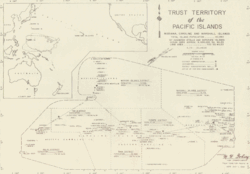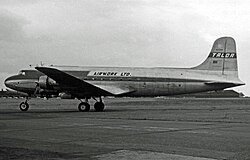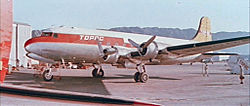Transocean Air Lines
| Transocean Air Lines | |
|---|---|

|
|
| IATA code : | (without) |
| ICAO code : | TL |
| Call sign : | TALOA |
| Founding: | 1946 |
| Operation stopped: | 1960 |
| Seat: |
Oakland , California United States |
| Home airport : | Oakland Municipal Airport |
| Fleet size: | 19th |
| Aims: | worldwide contract flights |
| Transocean Air Lines ceased operations in 1960. The information in italics refer to the last status before the end of operation. | |
Transocean Air Lines (TAL for short, also known as Taloa ) was an Oakland- based US airline that offered non-stop flights worldwide . The company was entrusted , among other things, with the resumption of air traffic between the Pacific islands . Transocean Air Lines carried out civil and military contract flights and also used their machines in wet leases for other airlines. In the early 1950s, it was the world's largest charter airline ( “Supplemental Airlines” ). At that time, the company had around 3,000 employees and, in addition to a fleet of more than 100 aircraft, had an international network of branches and maintenance stations. The company ran into economic difficulties from the mid-1950s and filed for bankruptcy in 1960 .
founding
In early 1946, United Air Lines had signed a tender to set up two military charter flights a day from California to Hawaii , but the company did not have enough of its own personnel to carry out this eleven-month contract. The management offered the United pilot Orvis M. Nelson to organize the flights and subcharter them for the company. Orvis Nelson, who had served in the Air Transport Command (ATC) during World War II , was able to win over his former squadron members for the project. Flight operations began on March 16, 1946 under the name Orvis Nelson Air Transport Company ( ONAT ) with twelve leased Douglas C-54s . On June 1, 1946, the company was named Transocean Air Lines . In the same year Nelson concluded a two-year contract with Philippine Air Lines and carried out their first scheduled flights to California and later to Europe with further Douglas C-54s . At the same time he opened the Taloa Flight Academy in Oakland, an international training center for pilots and flight engineers . This subsidiary used at times over 50 single-engine machines for training purposes.
In 1947, Transocean Air Lines was able to sign several long-term charter contracts and carried around 7,000 immigrants from Great Britain to Canada as well as fisheries workers from Seattle and California to Alaska . In addition, the company carried out many individual orders on international occasional flights. In order to avoid empty flights, new freight was acquired after arrival at the destination, so that the machines often drove to several airports before they returned to Oakland loaded. This business model, which was similar to tramp shipping , led to the first individual machines orbiting the earth. In the spring of 1948 the US government commissioned the company with the transfer of 150 Curtiss C-46 transport aircraft to Shanghai , where they were handed over to the troops of Chiang Kai-shek .
Worldwide operations

After Transocean Air Lines first carried out pilgrimage flights in the Middle East in 1947 , the following year it signed a long-term leasing contract with Iranian Airways and used five aircraft for shuttle services between Tehran and Jeddah . The company then also carried out pilot training and maintenance for Iranian Airways . From 1948 onwards, scheduled flights were carried out on behalf of Pakistani Pak-Air from Karachi to London and Singapore, as well as training programs for their future pilots. In the same year, Transocean began to take part in the Berlin Airlift with seven aircraft and carried several thousand war brides from Munich to the USA in "Operation Flying Bride" . There were also connecting flights for the United States Air Force because their capacities were limited by the airlift. Starting in 1948, around 25,000 East European war displaced persons, mostly from Munich to South America , Australia and the USA, were flown for the International Refugee Agency . That same year, the Venezuelan government hired the company to begin scheduled services between Caracas and Rome to accommodate Italian immigrants. At the same time, Transocean Air Lines opened numerous branches and maintenance facilities in the USA, Europe and Asia, where machines from other airlines and the US armed forces were also overhauled.
Through contacts with the governor of French Somaliland , the subsidiary Air Djibouti was founded in 1949 , the operational base of which had to be set up in Asmara for legal reasons . 1) The company rented Curtiss C-46 aircraft from Transocean Air Lines , which were used on passenger and cargo flights from Djibouti to Riyadh and Nairobi . After France of Air Djibouti had withdrawn landing rights for French Somaliland, developed since 1950 in close cooperation with the establishment of any Jordanian Air Jordan . For this, Transocean Air Lines initially used several Curtiss C-46 and Douglas DC-3 , later also Douglas DC-4, in wet lease on routes from Amman to Bahrain , Beirut , Damascus , Jeddah, Cairo and Nicosia . In addition, she trained the Jordanian crews. On March 7, 1952, the company acquired a 49% stake in Air Jordan , from 1953 it was also involved in Iranian Airways .

The United States Department of the Interior launched a tender in 1949 to reactivate civil aviation in the US-administered Trust Territory of the Pacific Islands , which had been inactive since the outbreak of the Pacific War . After winning the announcement addressed Transocean Air Lines a base at the Agana Naval Air Station in Guam and put used amphibious aircraft of the type Consolidated PBY into service. These were used from July 1, 1951 on scheduled flights from Guam to Saipan , via Yap to Koror and on a weekly round trip from Guam via Truk ( Carolines ), Ponape ( Micronesia ) to Majuro and Kwajalein ( Marshall Islands ). Because the flights on the circuit only took place during the day, the machines needed ten days for a complete circuit. Four Grumman Albatross aircraft replaced the Consolidated PBY on these routes from 1954.
With the beginning of the Korean War , the number of military charter orders skyrocketed from 1950. Transocean Air Lines then put a large number of additional Douglas DC-4s and C-54s into service and carried out around 14 percent of all US troop transports and supply flights to South Korea by the end of the war in 1953 . From October 1951, the company began using Martin 2-0-2 machines in wet lease for the newly founded Japan Air Lines , for which they also trained pilots, flight engineers and dispatchers . In addition, Transocean Air Lines was involved in setting up Japanese maintenance facilities. In 1954 pilot training for Lufthansa took place in the Taloa Flight Academy . The company also provided ten on- board navigators with which Lufthansa began its transatlantic traffic. From December 1957, two Douglas DC-4s and from March 5, 1959, a Lockheed L-1049 were operated in wet lease for Lufthansa on cargo flights to the USA.
1) Air Djibouti , founded by Transocean , was a different company than Air Djibouti of the same name , which only started operations in 1963.
Economic decline

After the end of the Korean War, the number of military and civil charter orders was no longer sufficient to utilize the greatly enlarged fleet. Transocean Air Lines tried several times from 1954 onwards for the approval of scheduled flight rights on transpacific routes, but the American aviation authority Civil Aeronautics Board (CAB) did not issue a corresponding permit. Due to the regulations in force at the time, US charter airlines ( "Supplemental Airlines" ) were not allowed to take up permanent flight connections or offer tickets in individual sales. In addition, the CAB could revoke the operating license of a “Supplemental Airlines” at any time, which made it difficult for these companies to find investors or to obtain long-term loans. Transocean Air Lines had to make up for losses in its operating business by selling most of its aircraft.
While the airline was making losses, its numerous subsidiaries continued to generate profits. In addition to various maintenance centers, flight schools and engineering offices, this also included restaurants, a hotel and a road construction company. In order to reduce the total costs and to find new investors, it was decided in October 1955 to merge the Transocean Air Lines with their until then legally independent subsidiaries. This resulted in the holding company The Transocean Corporation of California on June 1, 1956 .
In early 1957, New York-based investment firm Atlas Corporation , which also had stakes in Northwest Airlines , acquired 40 percent of the company's shares . Transocean received the funds to finance the purchase of 14 used Boeing 377s from BOAC . The machines were first used in the summer of 1958 on military and civil charter flights ( Affinity Group charter ) to Europe. By partially easing the strict CAB regulations, Transocean was able to set up a fixed connection from Oakland via Hawaii , Wake and Guam to Okinawa , which was flown twice a week. For this route, the company offered national connecting services from Oakland via San Francisco to Chicago and New York . The small number of missions was not enough to operate the existing Boeing 377 economically. When further financial aid was needed in November 1958, the Atlas Corporation took over the majority stake in the company and began selling the still profitable divisions to the highest bidder. Transocean was then unable to offset its losses in flight operations with revenue from other business areas. The desperate financial situation in the course of 1959 meant that several Boeing 377s had to be stored and used as spare parts donors for the other aircraft. In early 1960 the company stopped all charter flights. Air services in the Pacific Trust Areas continued until bankruptcy on July 11, 1960.
Incidents
From 1949 until the cessation of operations in 1960, Transocean Air Lines suffered five total aircraft losses. In all five of them, a total of 106 people were killed. Full list:
- On August 15, 1949, the pilots of a Douglas DC-4 / C-54 ( aircraft registration number N79998 ) had to ditch a nightly ditch about eight miles off the west coast of Ireland . The plane coming from Rome had initially flown far out into the Atlantic instead of landing in Shannon . After the crew noticed their mistake and vice versa, the fuel ran out. Seven passengers and one crew member were killed in the ditching. The other 50 inmates were rescued by the crew of a fishing trawler .
- On November 5, 1951, a Martin 2-0-2 (N93039) was flown into the ground near Tucumcari Municipal Airport ( New Mexico ) . At the time of the accident, the field of vision was below the minimum permitted for a landing. One passenger was killed; the other 28 inmates survived the incident.
- On December 30, 1951, a Curtiss C-46 (N68963) had an accident near Fairbanks ( Alaska ). The pilots had previously announced that the radio compass (ADF) had failed. The cargo plane was only found four days after the accident. The four inmates were killed.
- On 20 March 1953 it Douglas DC-4 / C-54 crashed (N88942) , while they are close Oakland in a holding pattern circling. The cause of the loss of control could not be determined. All 35 occupants died in the impact.
- On July 12, 1953, a Douglas DC-6 (N90806) had an accident about 630 km (340 NM) east of Wake Island in the Pacific Ocean . There were 58 people on board. The few debris found indicated that the plane had hit at high speed. The cause of the accident remained unclear (see also Transocean Air Lines flight 512 ) .
fleet

Fleet at the end of operations
In the year of the cessation of operations, the fleet consisted of eight Boeing 377s (six more were not airworthy as spare parts donors ), three Douglas DC-4s, three Grumman SA-16A, three Lockheed L-749A and two Lockheed L-1049H.
Previously deployed aircraft
Throughout its history, Transocean Air Lines also operated the following types of aircraft:
Trivia

- The term Taloa , under which the company was also known stand for T ransocean A ir L ines Oa kland . The aircraft carried this name until the introduction of the Boeing 377 on the vertical stabilizer . It was also used as a call sign and as a baptismal name for some aircraft (e.g. "Taloa Manila-Bay" ). The company's employees called themselves “Taloans” .
- The Transocean pilot Ernest K. Gann wrote the novel for the feature films " The Last Signal " ( "Island in the Sky" ) and " It will always be day " ( "The High and the Mighty" ). Machines from Transocean Air Lines were used to shoot both films . In addition, scenes from the feature film “ Murder in the Clouds ” ( “Julie” ) were filmed at the Taloa Flight Academy .
- Thailand commissioned the company in January 1950 to transport its gold reserves, which were seized by the Japanese, with a total value of 46 million US dollars at the time, from Tokyo for storage in the USA. Due to the heavy weight of the cargo, several Douglas C-54s were used in the shuttle service, each loaded with gold bars worth 6 million US dollars.
- In 1952, the Transocean shipyard in Oakland ( AEMCO ) built a Douglas DC-4 destined for the Saudi King Abd al-Aziz ibn Saud into a “Flying Palace” with a throne. A retractable elevator was installed on the rear cargo hatch to enable the king sitting in a wheelchair to get in. Franklin D. Roosevelt's presidential machine, the VC-54C “Sacred Cow” served as a model .
- After the Transocean captain Andrew Madsen saw a stroboscope in Germany , he came up with the idea of increasing the luminosity of position lights in this way. The Taloa owned subsidiary AEMCO upgraded in 1955 for the first time a test machine with strobe lights and developed this technology to market more (then "Madsen Lights" called). The white flashing collision warning lights (known today as strobes ) have since been used as standard in civil and military aviation.
See also
Web links
Individual evidence
- ^ A b Orvis Nelson and the Transocean Air Lines Experience
- ↑ ONAT - First a Dream; Now to the airline
- ↑ Around the World with Transocean Air Lines, The Manila Connection
- ↑ a b c d Aircraft operated by Transocean Air Lines
- ↑ Flight International, November 6, 1947 (PDF)
- ^ Transocean Air Lines - Salmon
- ^ W. David Lewis: Airline executives and federal regulation. Case studies in American enterprise from the airmail era to the dawn of the jet age . Ohio State University Press, Columbus 2000, ISBN 0-8142-0833-9 .
- ^ Transocean Air Lines - China
- ^ Transocean Air Lines - Orvis' Orient Express
- ^ Transocean Airlines - Pakistan
- ^ Transocean Air Lines - The Berlin Airlift
- ^ Transocean Flies the Military - Operation Flying Bride
- ↑ a b c d e f g h i Orvis Nelson and the Transocean Air Lines Experience
- ^ Transocean Air Lines - Flight to Freedom
- ^ Transocean Air Lines - Holy War
- ^ A b Transocean Air Lines - The First Aviation Conglomerate
- ↑ Transocean Air Lines - Air Djibouti & Air Jordan
- ^ Civil Aeronautics Board: Civil Aeronautics Board Reports, Volume 23, Economic and Safety Enforcement Cases, January – August 1956 , US Government Printing Office, Washington 1960, p. 446.
- ↑ Flight International, April 20, 1956 (PDF)
- ^ Transocean Air Lines - Guam & The Trust Territory
- ↑ TALOA Truk a Livesaver
- ^ Transocean Air Lines - Japan
- ^ Transocean Air Lines - Germany
- ↑ Flight International, May 13, 1955 (PDF)
- ^ Flight International, May 13, 1960
- ^ Flight International, April 10, 1959
- ^ Transocean, flight plan 1958
- ^ Transocean Air Lines - End of a Golden Age
- ↑ Accident statistics Transocean Air Lines , Aviation Safety Network (English), accessed on June 23, 2020.
- ↑ accident report DC-4 N79998 , Aviation Safety Network (English), accessed on March 13 of 2019.
- ↑ accident report Martin 2-0-2 N93039 , Aviation Safety Network (English), accessed on 10 November 2017th
- ↑ accident report C-46 N68963 , Aviation Safety Network (English), accessed on 23 June 2020th
- ↑ Accident report DC-4 N88942 , Aviation Safety Network (English), accessed on June 23, 2020.
- ↑ ICAO Accident Digest Circular 39-AN / 34 (PDF)
- ^ Accident report DC-6 N90806 , Aviation Safety Network (English), accessed on June 23, 2020.
- ^ Flight International, April 8, 1960
- ^ Aero Transport Data Bank, Transocean Air Lines
- ^ Fleet list, Transocean Air Lines
- ^ Transocean Air Lines, Making Movies
- ↑ Flying "Anything, Anywhere, Anytime," Operation Gold Rush
- ↑ Transocean Air Lines - Hangar 28
- ↑ Flight International, August 15, 1952 (PDF)
- ^ Transocean Air Lines - Madsen Lights and other TAL Inventions